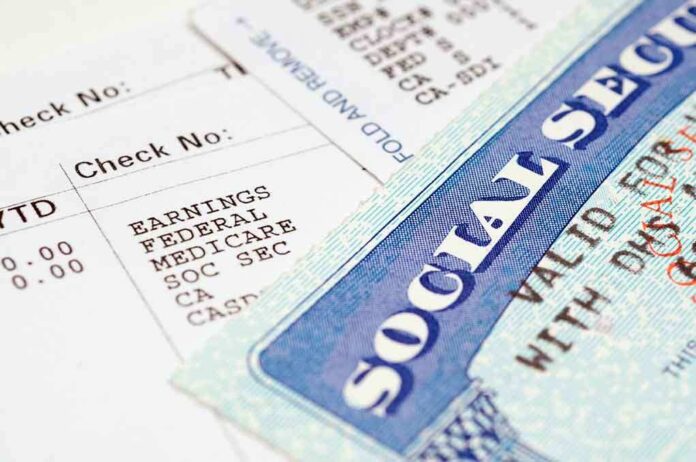
Some Americans are quietly collecting Social Security checks three times higher than the average retiree—what’s their secret, and can you join their ranks?
Story Snapshot
- The average monthly Social Security payout is $1,976, yet a select few receive the maximum of $5,108.
- Key factors: earning the annual maximum taxable salary, working at least 35 high-earning years, and delaying benefits until age 70.
- Most retirees don’t maximize all three, but understanding the formula can boost your own payout.
- Social Security alone can’t guarantee a luxurious retirement, but a bigger check makes all the difference.
The Elusive Maximum Check: Why So Few Hit the Social Security Jackpot
Out of millions of retirees, only a tiny fraction receive the maximum Social Security benefit—currently $5,108 per month. Most Americans settle for far less, often because they don’t know the formula behind those jumbo checks. The Social Security Administration sets the rules: benefits are based on your 35 highest-earning years, with annual caps on taxable income. For 2025, only earnings up to $176,100 count toward your future payout. Each year, this cap rises to reflect inflation, making the climb a bit steeper for each new retiree cohort.
Those who snag the maximum check did three things differently. First, they consistently earned at or above the taxable income limit for decades, weathering economic downturns and career setbacks. Second, they worked at least 35 years at those high levels—no gaps, no low-earning years dragging down their average. Finally, they waited until age 70 to claim benefits, forgoing early retirement temptations in exchange for a benefit up to 24% higher than if they’d filed at full retirement age. The result: a monthly deposit more than double the average, and a far more comfortable retirement.
How to Earn More: The Critical Role of Taxable Income
Social Security was built on a simple principle: you get out what you put in, up to a point. The system rewards those who pay the most into it, but only up to the annual taxable maximum. In 2025, that threshold is $176,100. If you earn more, you don’t pay more Social Security tax, and you don’t get a bigger benefit. The table of annual income caps shows a relentless upward march, from $118,500 in 2015 to $176,100 a decade later. Only those who hit or exceeded these numbers every year stack the deck in their favor. For most Americans, that means not just earning well, but doing so consistently and for longer than the average career span.
Missing the cap even a few years can leave thousands on the table. If you work only 25 years, Social Security calculates zero-income years for the other ten, diluting your average. On the other hand, working more than 35 years lets you replace your lowest-earning years with higher ones, maximizing your average and your benefit. This is not just about working harder or longer—it’s about strategic career planning and sometimes luck, as few careers offer such steady, high earnings year after year.
The Magic of Waiting: Why Delaying Pays Off Big
Claiming Social Security at the earliest possible age—62—tempts many, but it comes at a steep price. Early claimers receive up to 30% less per month for life compared to those who wait until full retirement age (between 66 and 67, depending on birth year). The real magic comes from waiting even longer. For every year delayed past full retirement age, benefits increase by about 8%, up to age 70. That’s how today’s $5,108 monthly checks are made: by waiting until the last possible moment. This decision requires discipline, financial backup, or part-time work to bridge the wait, but the reward is a lifetime of larger payments.
The system is designed to be actuarially fair, meaning whether you claim early or late, the total expected payout is roughly equal—if you live an average lifespan. But for those with longevity on their side, or simply those who prioritize a higher monthly income, waiting until 70 is the only way to experience the maximum benefit Social Security offers.
The Bigger Picture: Social Security as One Piece of the Retirement Puzzle
Even the maximum Social Security check is rarely enough to fund a luxurious retirement on its own. The program’s intent was never to be the sole source of income, but rather a foundation. Savvy retirees use every tool available—IRAs, 401(k)s, taxable brokerage accounts—to supplement their Social Security. But maximizing your government benefit gives you a stronger base, more flexibility, and a greater cushion against market downturns or unexpected expenses.
Few will qualify for the $5,108 monthly maximum, but every step toward it counts. Earning more, working longer, and delaying your claim each add dollars to your future checks. For those still in their working years, these strategies can mean the difference between scraping by and living well. For those approaching retirement, even modest adjustments—like delaying benefits a year or two—make a measurable difference. Social Security remains a critical asset, and maximizing it is one of the few “guaranteed return” strategies left in the modern financial landscape.
Sources:
As of 2025, the average Social Security retirement payment is $1,976
35% of Americans today are delaying retirement
This Social Security misconception might stop you
Save for retirement on your own












